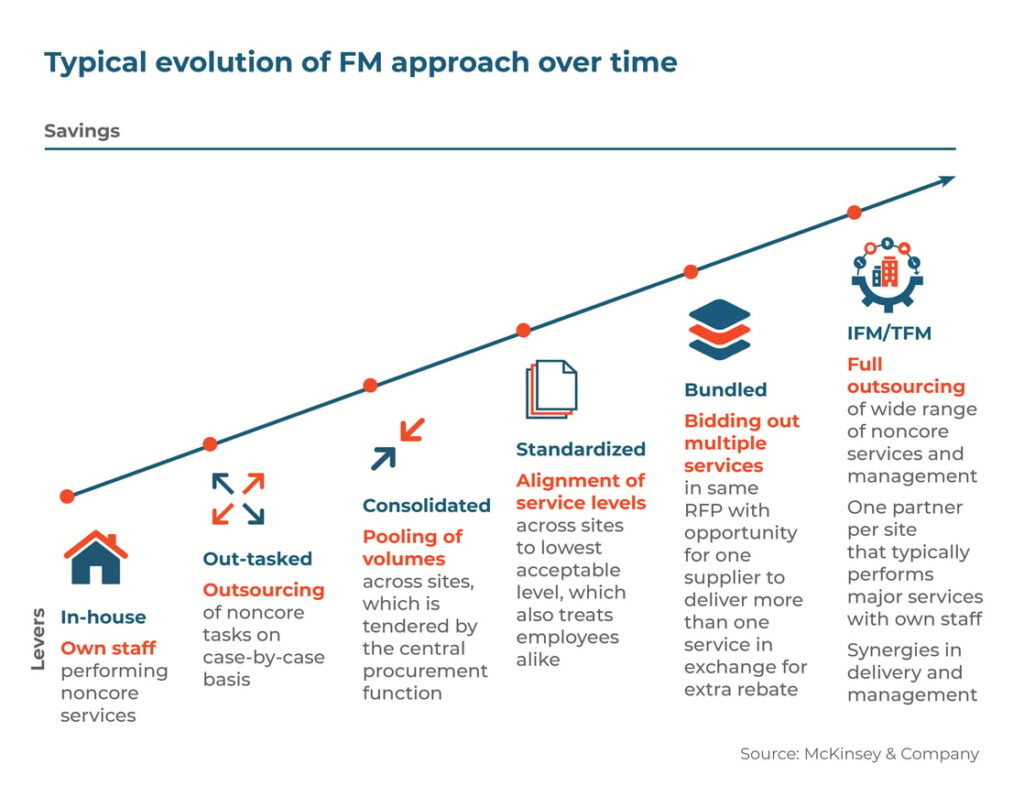Harnessing the Power of Total Facility Management for Streamlined Operations
Wiki Article
Exactly How Total Facility Management Boosts Upkeep and Workflow
Total Facility Management (TFM) represents a transformative change in exactly how organizations approach maintenance and procedures. By leveraging data-driven methods and incorporated technology, TFM not just prepares for and mitigates prospective problems yet additionally maximizes source allowance and enhances performance.Enhanced Upkeep Techniques
Boosted Upkeep Approaches are important for optimizing the efficiency and longevity of facilitiess. These techniques include a methodical approach to maintenance that highlights proactive procedures, predictive analytics, and condition-based monitoring. By implementing such methods, organizations can properly reduce unintended downtimes and minimize functional disturbances.One vital component of improved upkeep is using data-driven decision-making devices. These devices enable facility supervisors to analyze historic performance data, identify patterns, and forecast potential failures prior to they occur. This anticipating maintenance technique not only expands the life process of devices yet also boosts safety and security and compliance requirements.
Encouraging and educating upkeep employees are just as vital in executing enhanced strategies (Total Facility Management). Trained team can perform regular examinations and address small concerns prior to they intensify. Furthermore, taking on a thorough property management system assists in monitoring of devices status, maintenance background, and organizing of safety nets
Streamlined Operational Workflows
Enhancing operational operations is critical for the total effectiveness of facility management. By carrying out streamlined processes, companies can minimize redundancies, reduce delays, and boost performance. A well-structured operational workflow permits facility managers to allot resources efficiently, ensuring that jobs are completed in a timely way.Utilizing facilitiess management software program can automate routine jobs such as job order management, stock tracking, and organizing. Clear interaction channels amongst group members foster partnership and liability, further improving functional efficiency.
Standardizing treatments is an additional vital part. Developing best methods assists make certain that all employee are lined up in their strategy, reducing the possibility of mistakes and boosting solution distribution. Regular training and updates on workflow processes likewise play a crucial duty in maintaining consistency and performance.
Ultimately, structured operational workflows contribute to a much more responsive facility management system, enabling companies to concentrate on strategic campaigns rather than being bogged down by administrative concerns. By prioritizing efficiency, facility managers can significantly enhance the overall efficiency of their procedures.
Proactive Concern Resolution

Normal evaluations and monitoring systems play a critical role in this procedure, enabling facility managers to collect information and anticipate prospective failings. Additionally, fostering open interaction networks among staff members urges the very early reporting of problems, better assisting in prompt resolutions.
Implementing an extensive facility management software program can enhance the monitoring of upkeep tasks and problem coverage, offering important insights right into persisting troubles and their origin. This data-driven approach permits notified decision-making and prioritization of resources.
Inevitably, proactive issue resolution not only preserves the honesty of facility operations however additionally improves worker satisfaction and security. By investing in techniques that concentrate on prevention, companies can create a much more efficient and durable functional atmosphere, setting a solid structure for future growth and success.
Price Efficiency and Source Management
Just how can companies achieve an equilibrium between cost performance and reliable source management in facility procedures? The assimilation of total facility management (TFM) offers a critical structure that improves monetary efficiency while optimizing resource allotment. By settling services, companies can improve procedures, reduce redundancies, and utilize economic situations of scale.Effective resource management starts with a complete analysis of existing assets and functional processes. Making use of data analytics, organizations can recognize underutilized sources and address inadequacies. This informed approach allows the execution of targeted upkeep routines, thereby extending go to this web-site possession life and reducing unintended downtime.

Training and advancement of facility management employees even more enhance expense performance by equipping them with the skills required to manage resources deliberately. Eventually, by embracing an all natural approach to facility management, organizations can achieve considerable price savings while ensuring that operational effectiveness continues to be a top priority.
Sustainability and Environmental Impact
The assimilation of total facility management (TFM) not only boosts expense effectiveness but additionally plays an essential duty in advertising sustainability and reducing environmental effect. By embracing an alternative method to facility procedures, TFM helps with the execution of sustainable methods that decrease resource intake and waste generation.Among the key parts of TFM is the optimization of power use. This includes the fostering of energy-efficient modern technologies, regular upkeep of HVAC systems, and the use of clever building management systems. These actions not just lower utility costs yet also dramatically lower greenhouse gas exhausts.
Furthermore, TFM advertises using sustainable materials in facility maintenance and renovation projects. By focusing on eco-friendly items and techniques, facilitiess can decrease their total environmental footprint while cultivating healthier interior atmospheres.

Final Thought
In final thought, Total Facility Management substantially enhances upkeep our website and operations via organized techniques that emphasize predictive analytics and condition-based surveillance. TFM advertises lasting techniques, eventually leading to enhanced facility management outcomes and a culture of constant renovation within companies.
Total Facility Management (TFM) represents a transformative change in how organizations approach maintenance and operations. Making use of facilitiess management software can automate regular jobs such as work order management, stock tracking, and scheduling.How can organizations attain an equilibrium between price performance and reliable source management in facility procedures? try this out The combination of total facility management (TFM) provides a strategic structure that enhances economic performance while enhancing resource allowance.In conclusion, Total Facility Management substantially boosts maintenance and operations via systematic techniques that emphasize anticipating analytics and condition-based tracking.
Report this wiki page